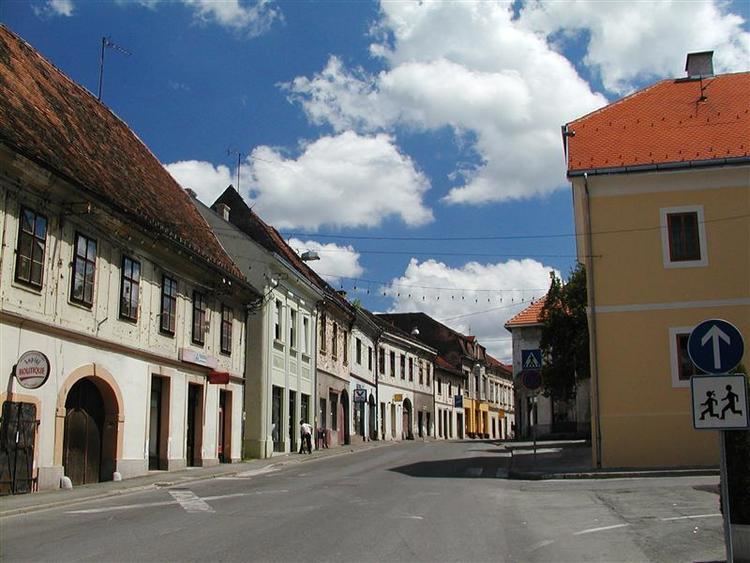Elevation 106 m (348 ft) Postal code 44 250 Area 41.64 km² Local time Wednesday 2:31 PM | Time zone CET (UTC+1) Vehicle registration PE Population 24,671 (2011) Area code 044 | |
 | ||
Weather 23°C, Wind NE at 8 km/h, 25% Humidity | ||
Petrinja is a town in central Croatia near Sisak in the historic region of Banovina. The city belongs to Sisak-Moslavina County (Sisačko-moslavačka županija).
Contents
Map of Petrinja, Croatia
History
The name of Petrinja has its roots in Latin petrus and Greek pètra, πέτρα, meaning "stone". It is said that the town existed in Roman era in the area of Zrinska Gora, which is very rich in stone.
West of Petrinja is Petrova gora (Peter's mountain), site of the 1097 Battle of Gvozd Mountain between King Petar Svačić of Croatia and Coloman of Hungary.
The first written trace of Petrinja as an inhabited settlement is the one about the benefits awarded to the inhabitants of Petrinja by the Slavonian duke Koloman in 1240. This old medieval Petrinja belongs to the time of warring with the Turks. In 1592, Petrinja was given a new location with the construction and building of a Turkish fortress at the confluence of the Petrinjčica and the Kupa rivers. The fortress was to serve the Turks in conquering Sisak, Turopolje and Zagreb.
In the year 1773, Austrian empress Maria Theresa decided upon Petrinja to be the centre for craft guild, which included the entire territory of the Military Frontier.
On August 10, 1594, the fortress was first liberated by the Croatian army. Therefore, August 10 has become the day of gratitude towards God and St. Lawrence, and this saint has been chosen for the patron saint of the parish and the town of Petrinja. Over the time, Petrinja has increasingly become the place of the settlement for many craftsmen and merchants whose arrival marks the beginning of the town's development.
Petrinja was part of Napoleon's Illyria from 1809 till 1813 when the town became a significant trade and traffic center. In the same period, the French army planted the lindens that even today testify to the town's historical moment.
The first Catholic parish Church of St. Lawrence was first built in 1603, but due to the time and type of building, a new one was built in 1781, in late baroque—classicist style.
The foundations of the Prva hrvatska tvornica salame, sušena mesa i masti (first Croatian salami, cured meat and lard factory) were set in the year 1792, now developed into the "Gavrilović" factory, the principal factor of the area's economic development, well known for the quality of its gastronomical products.
The influence of Croatian national revival in the 19th century was felt in Petrinja. That was the time of the founding of the Town Orchestra (1808), Music Department (1841), Library and reading-room (1842), Teachers' Training School (1862), Croatian Choir "Slavulj" (1864), Town fire-brigade (1880), First printing-house (1881).
In the late 19th and early 20th century, Petrinja was a district capital in the Zagreb County of the Kingdom of Croatia-Slavonia.
From 1929 to 1939, Petrinja was part of the Sava Banovina and from 1939 to 1941 of the Banovina of Croatia within the Kingdom of Yugoslavia.
Recent history has witnessed the war in Croatia during which the people were exiled from their hometown of Petrinja in the period from September 1991 till May 1995. The town itself has been through a very grave destruction. On November 25, 1991 the Serb mayor of Petrinja Radovan Marković sent a message to Željko Ražnatović to have his troops enter the city as part of a "2. motorized battalion" of the 622. Motorized Brigade of the Yugoslav People's Army. Beholding Croatian identity, many monuments have been erected in memory of the Croatian war heroes and victims of the war.
In reconstructing and rebuilding their town, the inhabitants of Petrinja took great care of the town's urban tradition by keeping the old customs alive, celebrating Catholic holidays, and organizing numerous cultural, social and sports events.
There is a very lively tradition of the potting and ceramic crafts, which represent the main souvenir production of the items characteristic for this area, all made of high quality clay. The main souvenir is "stucka", an ornamented multi-use jar made of clay that has become a symbol of the town of Petrinja.
Culture
A statue of Croatian politician Stjepan Radić was made in Petrinja in 1929 by Mila Wood after his assassination the previous year. In 1936, the statue was placed in the city's central square, which was named after him. In 1963 the communist regime moved the statue to a city park. In 1991, the statue was damaged and thrown into an orchard in a nearby village. It was not found until 1998, when it was restored. In 1999, it was restored to Petrinja's central square, and was unveiled by Croatian minister of culture Božo Biškupić.
Demographics
The population of Petrinja is 24,671, of which 15,683 live in the urban settlement.
The municipal area includes the following settlements:
